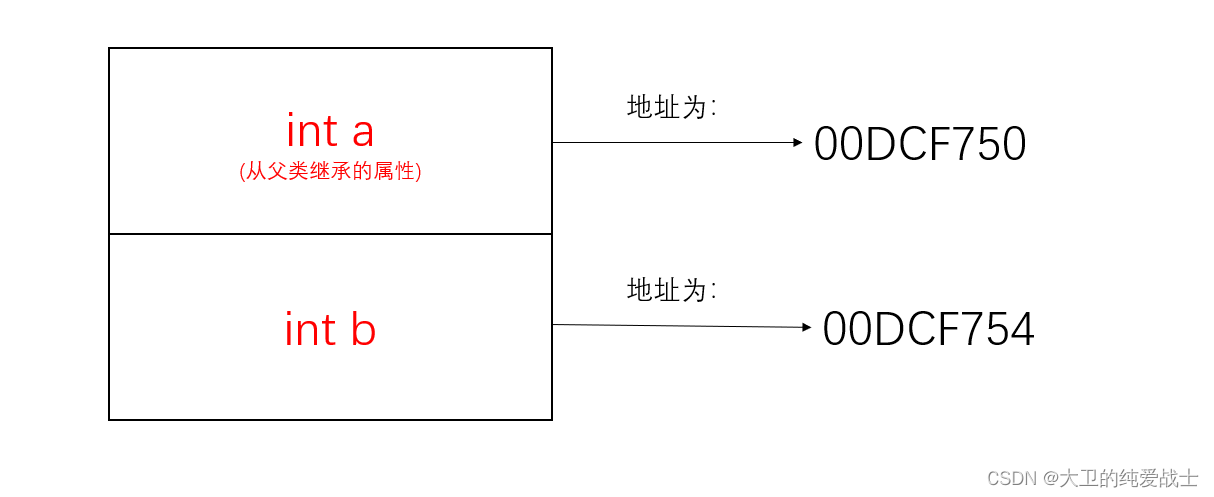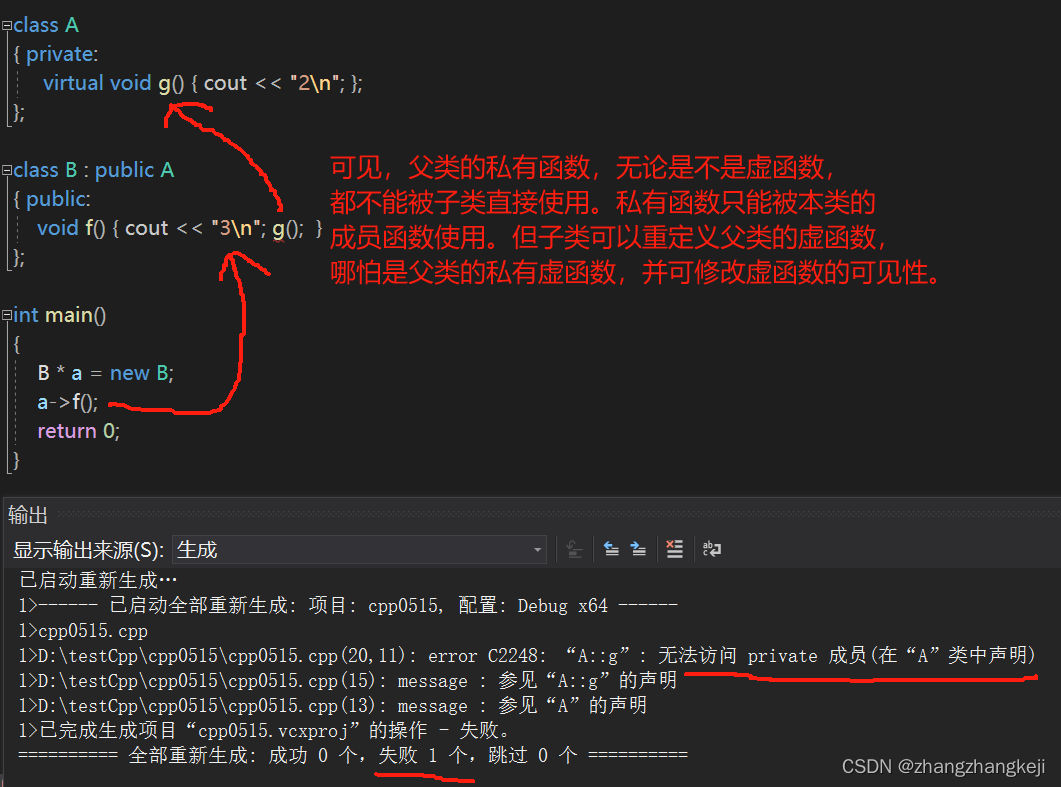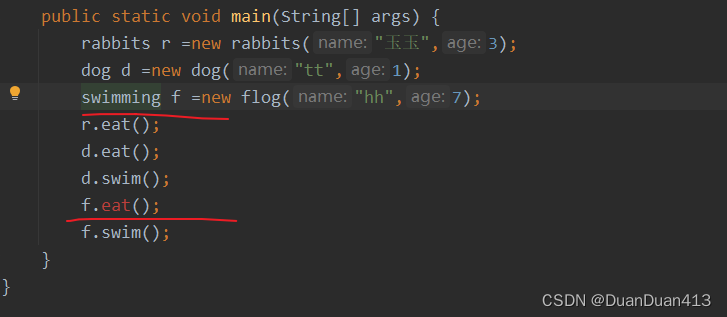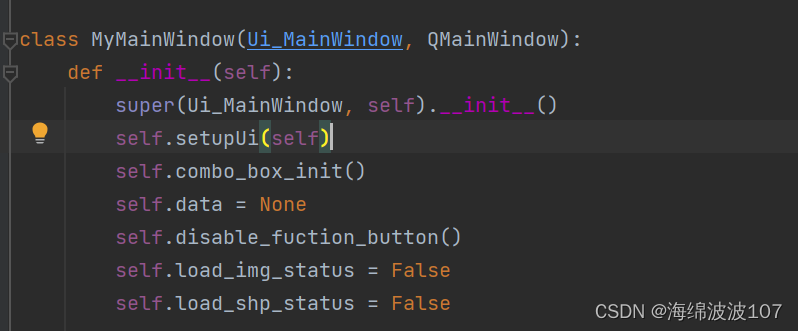子类专题
c++11工厂子类实现自注册的两种方法
文章目录 一、产品类构建1. 猫基类与各品种猫子类2.狗基类与各品种狗子类 二、工厂类构建三、客户端使用switch-case实现调用不同工厂子类四、自注册方法一:公开注册函数显式注册五、自注册方法二:构造函数隐形注册总结 一、产品类构建 1. 猫基类与各品种猫子类 class Cat {public:virtual void Printer() = 0;};class
获取所有classpath指定包下类的所有子类
1.问题 开发过程中,有时需要找到所有classpath下,特定包下某个类的所有子类,如何做到? 2. 实现 比较常见的解决方案是自己遍历目录,查找所有.class文件。 下面这个方法使用spring工具类实现,简化过程,不再需要自己遍历目录 /*** 获取在指定包下某个class的所有非抽象子类** @param parentClass 父类* @param packagePat
泛型第二课,派生子类、属性类型、方法重写、泛型擦除
子类(实现类) 子类与父类|接口一样使用泛型子类指定具体的类型子类与父类|接口 同时擦除类型子类泛型,父类|接口 擦除错误:不能子类擦除,父类|接口泛型 package com.pkushutong.genericity3;/*** 父类为泛型类* 1、属性* 2、方法* * 要么同时擦除,要么子类大于等于父类的类型* 不能子类擦除,父类泛型* 1、属性类型* 父类中,随父类型定
【大数据Java基础-JAVA 面向对象14】面向对象的特征二:继承性 (三) 关键字:super以及子类对象实例化全过程
关键字:super 1.super 关键字可以理解为:父类的 2.可以用来调用的结构: 属性、方法、构造器 3.super调用属性、方法: 3.1 我们可以在子类的方法或构造器中。通过使用"super.属性"或"super.方法"的方式,显式的调用父类中声明的属性或方法。但是,通常情况下,我们习惯省略"super." 3.2 特殊情况:当子类和父类中定义了同名的属性时,我们要想在子类中调用父类
Drawable 的 子类
从Drawable的继承结构上看,还有几个没有介绍到。 1、ColorDrawable ColorDrawable使用很简单,使用<Color>元素就可以定义一个ColorDrawable,然后再其他的地方使用。 在color.xml文件中定义: [java] view plaincopy <?xml version="1.0" encoding="utf-8"?> <color
穿越Java世界的继承奇旅:从基类到子类的华丽蜕变
1.为什么要继承 2.什么是继承以及继承的方式 3.继承的一些语法 4.父类成员的访问 5.关键字super 6.关键字protected 7.关键字final 8.继承与组合 一:为什么要继承 ①代码重用:继承允许我们重用、扩展或修改父类的属性和方法,而无需重新编写相同的代码。这有助于减少代码冗余,提高代码的可维护性和可扩展性。 ②实现多态:多态是面向对象编程的三大特性之
scrapy--子类CrawlSpider中间件
免责声明:本文仅做分享参考~ 目录 CrawlSpider 介绍 xj.py 中间件 部分middlewares.py wyxw.py 完整的middlewares.py CrawlSpider 介绍 CrawlSpider类:定义了一些规则来做数据爬取,从爬取的网页中获取链接并进行继续爬取. 创建方式:scrapy genspider -t crawl
OC一般类(简单类,组合类,继承关系的子类)的拷贝
1、对于简单的类而言,如果想要实现拷贝操作,就需要先将这个类遵守NSCopying协议,然后在它的实现文件即.m文件中实现-(id)copyWithZone:(NSZone *)zone方法,在方法内以allocWithZone的方式分配内存,若本类实现有初始化成员方法则直接调用初始化方法并用自身成员变量作为实参对其相应的形参进行赋值 ,然后生成新的对象指针,把新的对象指针返回即可;若本身没有
python 父类与子类的一些说明
Python中类的初始化方法是__init__(),因此父类、子类的初始化方法都是这个,如果子类不实现__init__()这个函数,初始化时调用父类的初始化函数, 如果子类实现了这个函数,则要在这个函数里显式调用一下父类的__init__(),这跟C++,jAVA不一样,他们是自动调用父类构造函数的。 #初始化中调用父类初始化方法示例 #B是A的子类 class B(A):
java构造函数是否可继承,以及子类构造函数可否不使用super调用超类构造函数
转载地址:http://blog.csdn.net/iamluole/article/details/7973174 问题一:java的构造函数能否被继承? 笔者初学java看的一本书说:“java的子类自然的继承其超类的“非private成员”。 通常java的构造函数被设置为public的(若你不写构造函数,java自动添加的无参空构造函数就是public的),因本文中的类都在同一个包
Django 2.1.7 视图 - HttpResponse对象、子类JsonResponse、子类HttpResponseRedirect
关于视图的篇章 Django 2.1.7 视图Django 2.1.7 MVT模型示例 - 查询数据,返回渲染模板数据Django 2.1.7 视图 - 自定义404错误、500错误Django 2.1.7 视图 - HttpReqeust对象、QueryDict对象 HttpResponse对象 视图在接收请求并处理后,必须返回HttpResponse对象或子对象。在
Java中父类和子类的代码执行顺序
Java中(静态)代码块、(静态)变量的执行顺序 父类代码 public class Parent {static {System.out.println("Parent static block");}{System.out.println("Parent non static block");}final static Value i = new Value("Parent static
c++中从父类继承的属性在子类内存中如何显示?
目录 一、继承概念 二、示例 三、结论 一、继承概念 在C++中,继承是面向对象编程的一个重要特性,它允许一个类(称为派生类或子类)继承另一个类(称为基类或父类)的成员(包括数据成员和成员函数)。通过继承,派生类可以获得基类的特性,并且可以添加自己的新特性。 但是从从父类继承的属性在子类内存中如何显示呢?下面通过一个案例可以直观的看到显示的
JAXB 不同子类使用相同的元素名称
要求云主机、带宽、云硬盘配置的元素名称都为itemConfig,并且能根据对应的类生成正确的元素 。 使用@XmlMixed 和 @XmlElementRefs 可实现 //订单选项配置@XmlTransientpublic class OrderItemConfig {} //订单云主机配置@XmlRootElement(name = "itemConfig")public
c++里 父类私有的虚函数,也是可以被子类重写和继承的。但父类私有的普通函数,子类无法直接使用
谢谢 。今天看课本上有这么个用法,特测试一下。这样就也可以放心的把父类的私有函数列为虚函数了,或者说把父类的虚函数作为私有函数了。 再补充一例:
关于接口多态,何时使用接口名创建对象?何时使用子类创建对象?
接口创建对象只能创建他的实现类,所以会出现两种创建方式: 1、接口 对象名 = new 类名 2、子类对象 对象名 = new 类名 举个例子,swimming是一个接口,flog是他的一个实现类,重写了swimming的eat()方法 子类对象 对象名 = new 类名: 接口 对象名 = new 类名: 利用接口创建的报红: 原因: 使用接口类去引用对象是有前提条件的—实现
python子类调用其他.py文件的父类
main.py需要使用os.py中的构造类。 os.py中定义了一个Ui_MainWindow类 在main.py中定义了一个MyMainWindow子类,传入两个父类的变量名 super(Ui_MainWindow, self).__init__() super() super() 是一个内置函数,用于返回一个代表父类的对象,以便调用父类的方法。它主要用于多重继承的环境中,确保正确
Java中,关于在子类构造函数中调用父类构造函数完成对象创建的简单分析
在使用new进行对象创建时,其实是调用了其相关类的构造方法。也就是说,对象创建时,最先执行的是构造方法。若在构造方法中没有对其类中的成员变量进行初始化,则在构造方法执行完之前,即对象还没有创建完毕,其成员变量是不存在的(此处不存在指的是内存中没有此变量)。下面通过一个小例子来说明这种情况 class Teacher { private String title; String name =
子类继承父类静态变量问题
java示例: public class Main7 extends Father{//static int test = 11; public static void main(String[] args) {test++;Father father = new Father();System.out.println(test);}}class Father{static int test
根据不同类型 父类进去子类
假设有一个基类Base和几个继承自Base的子类Sub1、Sub2等,每个子类都会把自己的实例注入到一个静态的Map中。 首先,定义基类和子类: public class Base {// 抽象方法,子类需要实现public void doSomething() {throw new UnsupportedOperationException("Should be implemented in
Java子类与父类之间的对象转换(说明继承)
在使用Java的多态机制时,常常使用的一个特性便是子类和父类之间的对象转换。从子类向父类的转换称为向上转换(upcasting),通过向上转换,我们能够在编写程序时采用通用程序设计的思想,在需要使用子类对象的时候,通过把变量定义为父类型,我们可以通过一个变量,使用该父类型的所有子类型实例;从父类型向子类型的转换称为向下转换(downcasting),通过向下转换,我们能在必要的时候,将
Java面试八股之子类可以从父类继承哪些内容
Java子类可以从父类继承哪些内容 Java子类可以从父类继承以下内容: 属性(Fields/Variables): public:子类可以继承父类所有的public修饰的属性。 protected:子类可以继承父类所有的protected修饰的属性,无论子类和父类是否在同一个包内。 默认(无修饰符):如果子类和父类位于同一个包内,子类可以继承父类中默认访问修饰符(即没有明确修饰符)的属
C++类实例以及子类在内存中的分配
关于结构体和C++类的内存地址问题 今天终于有时间写点 东西了~ 太爽了 *_* 很多人都知道C++类是由结构体发展得来的,所以他们的成员变量(C语言的结构体只有成员变量)的内存分配机制是一样的。下面我们以类来说明问题,如果 类的问题通了,结构体也也就没问题啦。 类分为成员变量和成员函数,我们先来讨论成员变量。 一个类对象的地址就是类所包含的这一片内存空间的首地址,这个首地址也就对应具体
siteserver/sscms 关于我们页面-子类调用
<ul class="wrap nySubnav"><stl:channels channelIndex="关于我们"><stl:if testType="UpChannelOrSelf"><stl:yes><li class="current"><stl:a>{Channel.Title}</stl:a> </li></stl:yes><stl:no><li><stl:a>{Channel.Ti
子类构造和析构被执行时是否调用父类以及调用顺序
子类构造和析构被执行时是否调用父类以及调用顺序 1)子类被构造的时候会先调用父类的构造函数 2)子类析构的时候先调用子类的析构函数后调用父类的析构函数 如果直接用子类构造一个父类的对象,删除这个父类的对象不会调用子类的析构函数(父类的析构函数为虚函数除外) 示例代码: //A是一个父类 , 析构函数不是虚函数class A{publi
【一步一步了解Java系列】:子类继承以及代码块的初始化
看到这句话的时候证明:此刻你我都在努力 加油陌生人 个人主页:Gu Gu Study专栏:一步一步了解Java 喜欢的一句话: 常常会回顾努力的自己,所以要为自己的努力留下足迹 喜欢的话可以点个赞谢谢了。 作者:小闭 继承的概念以及继承存在的意义 Java中的继承是一种面向对象编程(OOP)的基本概念,它允许一个类(称为子类或派生类)继承另一个类(称为父类或基类)的属性和方法。继承提供了一种















